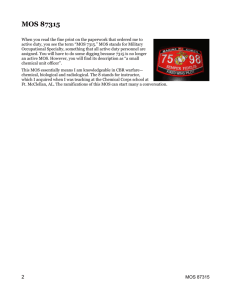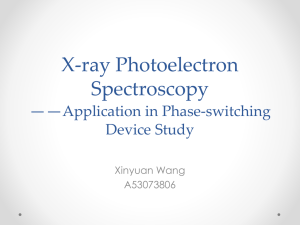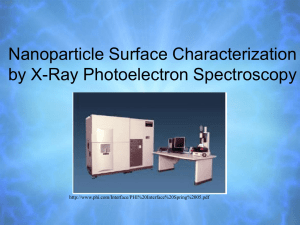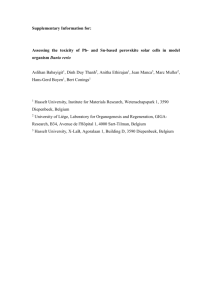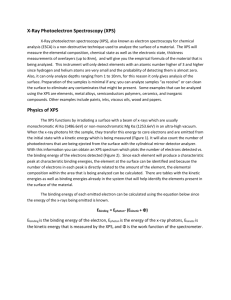The XPS measurements
advertisement
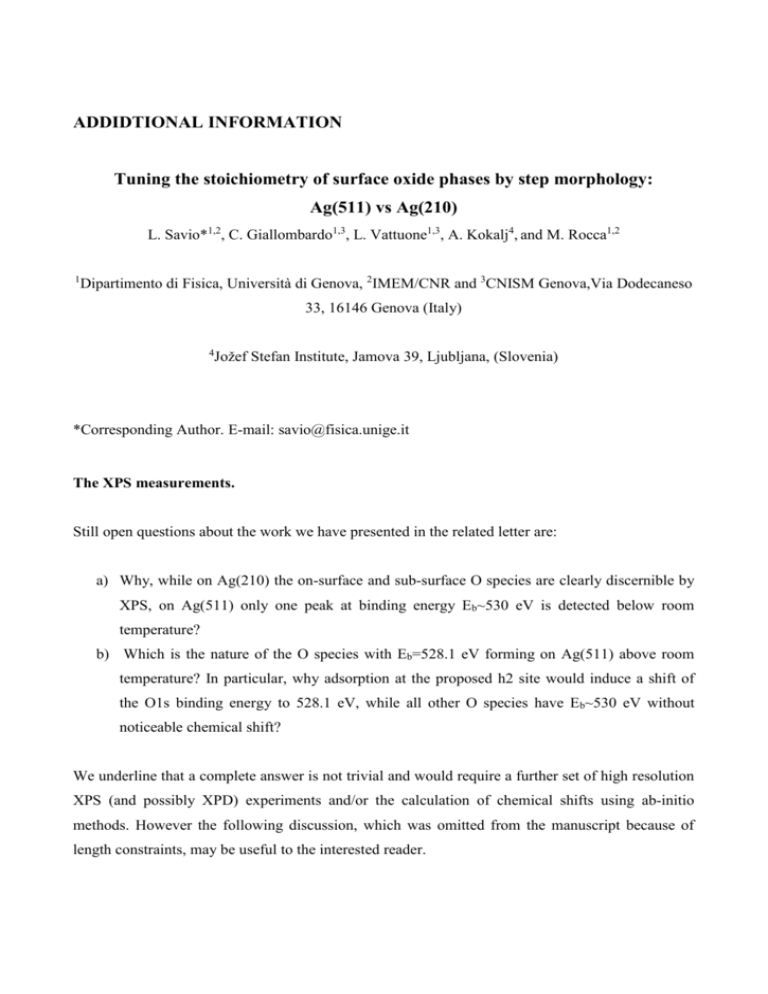
ADDIDTIONAL INFORMATION Tuning the stoichiometry of surface oxide phases by step morphology: Ag(511) vs Ag(210) L. Savio*1,2, C. Giallombardo1,3, L. Vattuone1,3, A. Kokalj4, and M. Rocca1,2 1 Dipartimento di Fisica, Università di Genova, 2IMEM/CNR and 3CNISM Genova,Via Dodecaneso 33, 16146 Genova (Italy) Jožef Stefan Institute, Jamova 39, Ljubljana, (Slovenia) 4 *Corresponding Author. E-mail: savio@fisica.unige.it The XPS measurements. Still open questions about the work we have presented in the related letter are: a) Why, while on Ag(210) the on-surface and sub-surface O species are clearly discernible by XPS, on Ag(511) only one peak at binding energy Eb~530 eV is detected below room temperature? b) Which is the nature of the O species with Eb=528.1 eV forming on Ag(511) above room temperature? In particular, why adsorption at the proposed h2 site would induce a shift of the O1s binding energy to 528.1 eV, while all other O species have Eb~530 eV without noticeable chemical shift? We underline that a complete answer is not trivial and would require a further set of high resolution XPS (and possibly XPD) experiments and/or the calculation of chemical shifts using ab-initio methods. However the following discussion, which was omitted from the manuscript because of length constraints, may be useful to the interested reader. XPS measurements on Ag(210) were performed at the ELETTRA synchrotron radiation source, with a high photon flux and a typical resolution better than 0.1 eV. Moreover, the binding energy of the AgO-like phase was 529.6 eV, i.e. degenerate with the one of carbonates but easy to evaluate by subtraction [1]. On the contrary, a conventional, non monochromatised X-ray source with a resolution of 0.9 eV was employed for experiments on Ag(511). Such resolution, sufficient to resolve a clearly separated oxide-related peak as the one detected on Ag(210), is not enough if the oxide intensity is embedded in the major peak due to chemisorbed oxygen. The information provided by XPS demonstrates that: a) Chemisorbed atomic and molecular oxygen and subsurface oxygen (oxide-like phase) give rise to a peak at an O1s binding energy Eb 530 eV. This is the only feature present in the O1s spectra below RT and results, evidently, from the superposition of the contributions of the above mentioned species. The difference in their Eb(O1s) must be smaller than experimental resolution. A summary of the O1s binding energy measured on Ag surfaces is reported in [2,3]. b) There is a further, on-surface atomic oxygen species with Eb=528.1 eV. It is stable above RT and strongly reactive towards CO. Since the XPS intensity at 528.1 eV grows in that temperature range in which the oxide related vibration at 68 meV disappears, we suggest that thermal dissolution of the oxide causes a, at least partial, segregation of oxygen atoms from the tetrahedral interstitials to the closest on-surface location (the h2 site). The existence of O species characterised by different O1s binding energy is not surprising [3]. In particular, on Ag(100) we reported both a covalent O moiety with Eb(O1s)=530.3 eV and an oxidic one with Eb(O1s)=528.3 eV, depending on crystal temperature [2]. The former corresponds to O-atoms sitting in the previous four-fold hollows of a missing row reconstructed surface while the latter consists of adatoms in the four-fold hollow sites of an unreconstructed Ag(100) layer. Now we note that, among all investigated sites on Ag(511), h2 is the only one with a pure four-fold hollow geometry since all Ag atoms have coordination 8 (i.e. equal to or larger than the coordination number on Ag(100) terraces). All other on-surface sites (h1, hcp and fcc) have at least two Ag atoms with reduced coordination. This may suggest a difference also in the chemical state of chemisorbed oxygen and thus in its O1s binding energy. Finally we mention that the investigation of Ag3d5/2 bands could not provide additional information since the resolution was not sufficient to investigate possible core-level shifts; surface core-level shifts are expected to be indeed quite small for Ag [4] and also in presence of a significant oxygen coverage the shift is of only -0.4 eV with respect to the Ag(100) atoms not in contact with O [2]. In our case the relative amount of the oxide-like phase with respect to chemisorbed oxygen is reasonably small, so that also a possible core-level shift would be small and difficult to be detected. [1] L. Savio et al., J. Phys. Chem. B 110, 942 (2006) [2] M. Rocca et al., Phys. Rev. B 61, 213 (2000) [3] A.I. Boronin, S.V. Koscheev and G.M. Zhidomirov, J. El. Spectr. and Rel. Phenomena 96, 43 (1998) [4] G. Pirovano et al. Phys. Rev. B 54, 8892, (1996)
